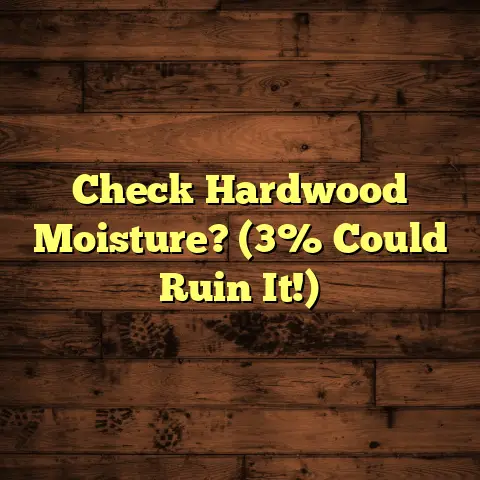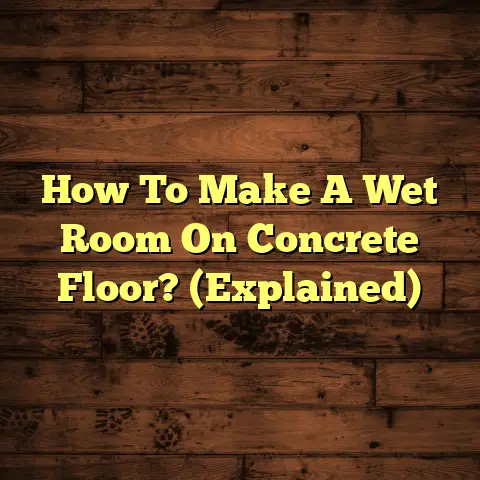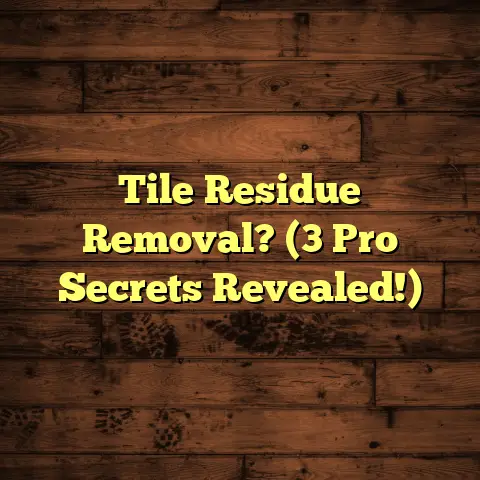Mold Under Wood Floors? (7 Warning Signs, ACT NOW!)
According to the Environmental Protection Agency (EPA), approximately 50% of homes in the United States have a mold issue. That’s a staggering statistic! Wood floors, with their organic nature and ability to retain moisture, are prime real estate for these unwanted guests.
Why should you care? Well, ignoring mold isn’t just about aesthetics. It’s about your health, your family’s well-being, and the structural integrity of your home. Imagine breathing in mold spores every day, leading to respiratory problems or allergic reactions. Not fun, right?
Think of it like this: a small leak under your sink might seem insignificant, but it can create a breeding ground for mold that spreads like wildfire. Early detection is key to preventing a full-blown mold infestation.
So, let’s dive into the warning signs and what you can do about it. Trust me, you’ll thank me later.
Section 1: Understanding Mold and Its Causes
Okay, so what exactly is mold? In simple terms, it’s a fungus that thrives in damp environments. It’s a natural part of our ecosystem, but it becomes a problem when it starts growing indoors.
Mold reproduces through tiny spores that float in the air. When these spores land on a surface with moisture, they start to grow. Think of it like planting seeds – you need water, soil, and sunlight for a plant to grow. Mold needs moisture, an organic food source (like wood), and a relatively warm temperature.
What are the common causes of mold growth under wood floors?
- Moisture Intrusion: This is the big one. Leaks from plumbing, leaky roofs, or even condensation can create the perfect environment for mold to flourish.
- High Humidity Levels: If your home has consistently high humidity (above 60%), you’re basically inviting mold to the party.
- Leaks: Even small, unnoticed leaks from appliances like dishwashers or refrigerators can seep under the floor and cause problems.
I remember one time, a client called me in a panic. She had a persistent musty smell in her living room, but couldn’t figure out where it was coming from. After some investigation, I found a slow leak under her dishwasher that had been going on for months. The subfloor was completely covered in mold!
Mold loves warm temperatures and poor ventilation. Basements and crawl spaces are particularly vulnerable because they tend to be cooler, damper, and less ventilated than other parts of the house.
The key to preventing mold growth is maintaining a dry environment. This means fixing leaks promptly, controlling humidity levels, and ensuring good ventilation in your home.
Section 2: The Importance of Early Detection
Why is early detection so important? Think of it as catching a cold early. You can take some over-the-counter medicine and nip it in the bud before it turns into pneumonia. The same goes for mold.
If you catch it early, you can often deal with it yourself or with minimal professional help. But if you let it go, it can spread like crazy, leading to serious health problems and costly repairs.
Mold spreads by releasing spores into the air. These spores can land on other surfaces and start new colonies. The longer you wait to address a mold problem, the more it will spread, making it harder and more expensive to get rid of.
I’ve seen families who ignored a small mold problem for months, only to end up having to tear out entire sections of their flooring and subfloor. The cost of remediation can easily run into the thousands of dollars.
Plus, there’s the health aspect. Mold exposure can cause a range of symptoms, from mild allergies to more serious respiratory problems. Children, the elderly, and people with weakened immune systems are particularly vulnerable.
Ignoring mold is like playing Russian roulette with your health and your home. It’s simply not worth the risk.
Section 3: Identifying Warning Signs of Mold Under Wood Floors
Alright, let’s get down to the nitty-gritty. How do you know if you have mold under your wood floors? Here are seven warning signs to watch out for:
Warning Sign #1: Musty Odor
This is often the first sign that something’s not right. A musty odor is a distinctive, earthy smell that’s hard to describe but easy to recognize once you’ve smelled it. It’s like the smell of damp basements or old, forgotten things.
If you notice a persistent musty smell in your home, especially near your wood floors, it’s a red flag. The smell is caused by the gases that mold releases as it grows and decomposes organic matter.
The intensity of the odor will depend on the amount of mold present and the ventilation in the area. You might notice it more strongly in certain rooms or at certain times of the day, especially when the humidity is high.
Don’t ignore a musty smell! It’s your nose’s way of telling you that something’s wrong.
Warning Sign #2: Discoloration or Staining
Keep an eye out for any unusual discoloration or staining on your wood floors or surrounding areas. This could be a sign of water damage or mold growth.
Look for dark spots, streaks, or patches on the surface of the wood. The color can range from green or black to brown or even white, depending on the type of mold.
You might also notice discoloration on the baseboards, walls, or ceiling near the floor. This is a sign that the mold has spread beyond the floor itself.
Check for water stains, which are often a precursor to mold growth. These stains can appear as rings or blotches on the wood.
I’ve seen cases where homeowners dismissed discoloration as just “old wood” or “character,” only to find out later that it was actually mold. Don’t make the same mistake!
Warning Sign #3: Warping or Buckling of Wood
Wood floors are designed to be stable and flat. If you notice that your floors are warping or buckling, it’s a sign that they’re exposed to excessive moisture.
Warping refers to the bending or twisting of the wood planks. Buckling is when the planks lift up from the subfloor, creating a raised or uneven surface.
Moisture causes the wood to expand, which can lead to warping and buckling. Mold growth can also contribute to these problems by weakening the wood fibers.
Run your hand over the floor to check for any unevenness. If you feel any bumps or dips, it’s a sign of warping or buckling.
Pay attention to areas that are prone to moisture, such as near doorways, windows, and plumbing fixtures. These are the most likely places to see warping or buckling.
Warning Sign #4: Visible Mold Growth
This is the most obvious sign of a mold problem. If you see visible mold growing on your wood floors or surrounding areas, you need to take action immediately.
Mold can appear in a variety of colors and textures. It might look like fuzzy patches, slimy spots, or powdery coatings.
Check under rugs, furniture, and appliances. These are areas where moisture can get trapped and mold can grow unnoticed.
Look for mold along the edges of the floor, where it meets the baseboards or walls. These are common areas for moisture to accumulate.
Don’t touch the mold! Mold can be irritating to the skin and can release spores into the air. If you see mold, it’s best to call a professional to assess the situation and remove it safely.
Warning Sign #5: Increased Allergy Symptoms
Mold exposure can trigger or worsen allergy symptoms in susceptible individuals. If you notice that your allergy symptoms are getting worse, especially when you’re at home, mold could be the culprit.
Common allergy symptoms associated with mold exposure include:
- Sneezing
- Runny nose
- Coughing
- Wheezing
- Watery eyes
- Skin rashes
If you suspect that mold is causing your allergy symptoms, consult with your doctor or an allergist. They can perform tests to determine if you’re allergic to mold and recommend appropriate treatment.
Warning Sign #6: Water Damage
Water damage is a major risk factor for mold growth. Any signs of water damage in your home should be investigated promptly to prevent mold from taking hold.
Look for water stains on the ceiling, walls, or floors. These stains can indicate a leak from above.
Check for leaks around plumbing fixtures, such as sinks, toilets, and showers. Even small leaks can create enough moisture to support mold growth.
Inspect your roof for any signs of damage, such as missing shingles or cracks. A leaky roof can allow water to enter your home and saturate the wood floors.
If you experience a flood or water damage event, it’s crucial to dry out your home as quickly as possible. Mold can start growing within 24-48 hours of water exposure.
Warning Sign #7: Unexplained Illness in Household Members
In some cases, mold exposure can cause more serious health problems than just allergy symptoms. If you or other members of your household are experiencing unexplained illness, mold could be to blame.
Symptoms of mold-related illness can include:
- Respiratory problems, such as asthma or bronchitis
- Chronic fatigue
- Headaches
- Memory loss
- Difficulty concentrating
If you suspect that mold is making you sick, consult with your doctor. They can perform tests to determine if mold exposure is contributing to your symptoms.
It’s important to note that not everyone is affected by mold in the same way. Some people are more sensitive to mold than others.
Section 4: The Consequences of Ignoring Mold Growth
Okay, so you know the warning signs. But what happens if you ignore them? Let me paint you a picture.
Health Risks: Long-term mold exposure can lead to chronic respiratory issues, such as asthma, bronchitis, and sinusitis. It can also weaken your immune system, making you more susceptible to other illnesses.
People with allergies, asthma, or other respiratory conditions are particularly vulnerable to the health effects of mold. Children, the elderly, and people with weakened immune systems are also at higher risk.
Structural Damage: Mold can eat away at wood floors and the underlying subflooring, weakening the structure of your home. Over time, this can lead to costly repairs.
Mold can also damage other materials in your home, such as drywall, insulation, and carpeting.
Financial Implications: Mold remediation can be expensive, especially if the problem is widespread. The cost of remediation can include:
- Mold testing and assessment
- Mold removal and cleaning
- Repair or replacement of damaged materials
- Air purification
Ignoring a mold problem can end up costing you far more in the long run than addressing it promptly.
I’ve seen homeowners who tried to save money by DIY-ing mold removal, only to make the problem worse. It’s always best to consult with a professional to ensure that the mold is removed safely and effectively.
Section 5: Conclusion and Call to Action
Alright, we’ve covered a lot of ground. Let’s recap the key points:
- Mold is a common problem in homes, especially under wood floors.
- Early detection is crucial for both health and home maintenance.
- There are seven warning signs to watch out for: musty odor, discoloration, warping, visible mold, increased allergy symptoms, water damage, and unexplained illness.
- Ignoring mold growth can lead to serious health risks, structural damage, and financial implications.
I urge you to take action if you notice any of these warning signs in your home. Don’t wait until the problem gets worse.
Inspect your home immediately for any signs of mold. Pay close attention to areas that are prone to moisture, such as basements, bathrooms, and kitchens.
If you suspect that you have a mold problem, call a professional mold inspector or remediation company. They can assess the situation and recommend the best course of action.
Don’t let mold take over your home and your health. Act now to protect your family and your investment.
Remember, I’m here to help! If you have any questions or concerns about mold under your wood floors, don’t hesitate to reach out.
Let’s keep our homes healthy and mold-free!





